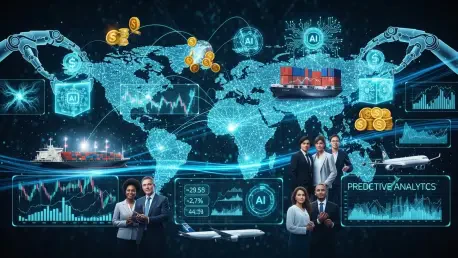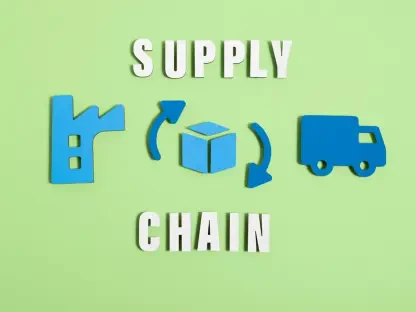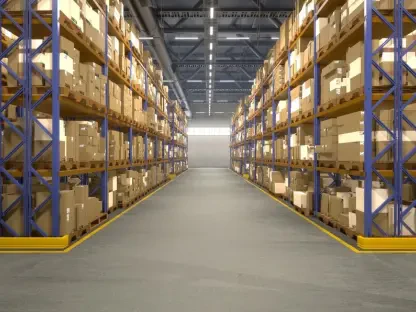Setting the Stage for a Trade Transformation
Imagine a world where a shipment of goods crosses multiple borders in half the usual time, with every document verified instantly and every route optimized to save costs and reduce carbon emissions. This is no longer a distant dream but a reality being shaped by artificial intelligence in cross-border trade. With global trade volumes reaching unprecedented levels, the complexity of navigating diverse regulations, customs protocols, and logistical challenges has become a significant barrier for businesses. AI emerges as a game-changer, automating cumbersome processes and providing real-time insights to tackle these hurdles head-on. This review dives deep into the capabilities of AI in transforming international trade, exploring its standout features, performance metrics, and the tangible impact it has on compliance and logistics.
Unpacking AI’s Role in Global Trade Operations
Core Features Driving Efficiency
At the heart of AI’s impact on cross-border trade lies its ability to automate and streamline critical operations that once relied heavily on manual intervention. One of the standout features is its proficiency in handling regulatory compliance. By leveraging Natural Language Processing, AI systems can classify goods under Harmonized System codes with precision, monitor real-time updates to trade laws across jurisdictions, and verify documentation for accuracy. This automation drastically cuts down on errors that often lead to costly delays or penalties, ensuring businesses stay aligned with international standards.
Another key feature is AI’s capacity to optimize logistics and supply chain management. Through predictive analytics, the technology forecasts the most efficient shipping routes by analyzing variables like weather, port congestion, and fuel costs. Dynamic inventory management, powered by machine learning, ensures stock levels are adjusted in real time to prevent overstocking or shortages. Additionally, AI-driven dashboards provide end-to-end visibility, allowing stakeholders to track shipments at every stage, a functionality that enhances transparency and builds trust across the supply chain.
Performance Metrics and Business Impact
When evaluating AI’s performance in cross-border trade, the numbers speak volumes. Industry leaders adopting this technology report clearance times reduced by significant margins, with some achieving up to 50% faster processing at customs checkpoints. Delivery reliability has also seen a marked improvement, as AI’s predictive models anticipate disruptions and suggest contingency plans before issues escalate. Cost efficiency stands out as a major benefit, with optimized routing and inventory control slashing operational expenses for shipping giants and small exporters alike.
Beyond raw metrics, the strategic impact of AI cannot be overlooked. Businesses using AI tools gain a competitive edge by shifting from reactive to proactive decision-making. The ability to predict market fluctuations or geopolitical risks allows companies to adjust strategies swiftly, mitigating potential losses. Moreover, the environmental benefits of AI-optimized logistics, such as reduced fuel consumption through smarter routing, align with growing demands for sustainable trade practices, enhancing corporate reputation in an eco-conscious market.
Real-World Success Stories
AI’s practical applications in cross-border trade are best illustrated through real-world deployments by industry frontrunners. A notable example is a global logistics provider that integrated AI to streamline customs processes, resulting in faster clearance for shipments across key trade corridors. By automating document verification and compliance checks, the company minimized errors and ensured smoother interactions with regulatory bodies, a boon for both efficiency and client satisfaction.
In another instance, a leading shipping corporation harnessed AI to tackle port congestion challenges. Using predictive algorithms, the system identified potential bottlenecks and rerouted vessels to less crowded ports, improving on-time delivery rates. This not only saved operational costs but also reduced idling times, contributing to a lower carbon footprint. Meanwhile, an e-commerce giant has leveraged AI to empower smaller exporters, simplifying complex customs procedures through automated tools, thus leveling the playing field for businesses of all sizes.
Challenges Hindering Seamless Adoption
Despite its transformative potential, AI’s integration into cross-border trade faces notable obstacles. Data privacy remains a pressing concern, as the technology relies on vast datasets that often include sensitive commercial information. Ensuring compliance with stringent regulations like GDPR while maintaining operational efficiency poses a significant challenge for developers and adopters alike. Robust security measures are essential to safeguard against breaches that could undermine trust in AI systems.
Integration with legacy systems presents another hurdle. Many trade entities still operate on outdated infrastructure that struggles to interface with cutting-edge AI solutions. This compatibility gap often requires substantial investment in upgrades, which can be a barrier for smaller firms. Additionally, the lack of transparency in AI decision-making processes raises questions about accountability, necessitating frameworks that ensure clarity and fairness in automated outcomes.
Final Thoughts on AI’s Journey in Trade
Looking back, this review highlighted how artificial intelligence redefined cross-border trade by automating compliance, optimizing logistics, and delivering measurable improvements in efficiency and cost savings. The technology proved its worth through real-world applications that showcased reduced clearance times and enhanced delivery reliability. Challenges like data privacy and system integration emerged as critical areas of concern, yet the overall performance of AI underscored its indispensable role in modern trade.
Moving forward, businesses must prioritize strategic investments in AI while addressing these challenges through robust security protocols and phased integration plans. Collaborating with technology providers to tailor solutions for specific trade needs could accelerate adoption. As the landscape evolves, staying ahead will require a commitment to leveraging AI not just as a tool, but as a cornerstone of competitive strategy in global commerce.









